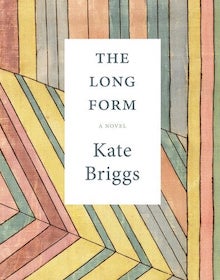
Dorothy, 2023
Late in her novel The Long Form, Kate Briggs quotes the Russian literary critic Mikhail Bakhtin: “There is never any problem, ever, which can be confined within a single framework.” Briggs’ novel is an architectural masterpiece that takes Bakhtin’s point as its premise; it is a novel that cannot be contained by any one form or way of reading, writing, or thinking. Composed of fragmentary sections that chronicle a single day in precise detail, The Long Form is about possibility itself—what reading and writing a novel can be, what mothering can be, and what a person can be. In Briggs’ prose, nothing is impossible.
Nothing happens in The Long Form, and yet everything happens. The novel tracks one day in the life of Helen, a new mother, and her baby, Rose. In the morning, a copy arrives of The History of Tom Jones (1749) by Henry Fielding, ordered a few days prior. Briggs describes Helen’s use of Tom Jones as a “narrative to cut life with, treating it as a very different place to go to (to go into) regularly, temporarily, a way of leaving, without ever really leaving, her own life.” (90) The Long Form documents Helen’s day with Rose—its joys and challenges, its disruptions and interruptions—as it is punctuated by Helen’s reading of Fielding’s classic novel.
Drawing on psychoanalysis, ideologies of motherhood, and theories of the novel and of fiction, The Long Form is a delightfully essayistic investigation of both formalism and mothering. Significantly, both forms and mothers are co-creations, ambiguous and malleable acts of care that are specific to unique sets of individuals—mother and child, writer and reader. In The Long Form, Briggs asks us to consider how we read—what acts of agency we undertake as readers—and, in our oneness with the text, to go back to the original union of child and parent. Of mothering Briggs writes: “It was a co-project, a complex interaction where, on both sides, the it’s all for you—this sense of an action so clearly undertaken for the priority-sake of you—was being ever-offset, resisted, or supported by the counter force of a me.” By the end, Briggs’ novel itself becomes a complex interaction, asking us to negotiate the push and pull of our reader-selves with Briggs’ writer-self in order to understand how Helen and Rose write and read their day as mother and child, and as unique and separate selves.
Of the novel Briggs, following Forster, writes that it “is interested in how one thing follows another” while also being “equally (arguably more) interested in what it feels like to live in time, in life lived by intensity.” She does both in The Long Form, documenting the quotidian by recording Helen’s temporal and spatial trajectories and showing how she understands ordinary life alongside the intensity of life that literature allows, through the intertextual presence of Tom Jones.
In precise, exacting fragments, Briggs writes into being motherhood and childhood—what it means for the child to become a self, and what it means for the mother to recognize herself as something new, a new mother-self. She writes: “Their common addressivity; their common responsivity. Two people, facing each other: occupying, for what Helen felt would be an incalculable time to come, the position of first responder (the other’s most immediate, first because always-on-the-scene, addressee).” Briggs is a generous explorer of how we understand our selves in relation to others, how we come into relation with them.
At the same time Briggs remains attuned to Tom Jones, attentive to its disruption of the morning’s routine and never losing sight of the impact it has on Helen, and the reader, even as Helen takes breaks from reading it. Glossing Fielding, who deploys similar pauses, Briggs writes: “He [drew] the reader’s attention to the techniques of linking, sequencing, transitioning between and piecing together smaller narrative units.” Briggs does this too, drawing our attention to her own linking, sequencing, and transitioning between smaller fragmentary sections in order to understand how Helen and Rose link and sequence themselves in the world.
The Long Form is formally disrupted by images, by sections, by fragments, but Briggs, ultimately, always circles around what it means to find joy in that disruption, as it offers new ways of thinking. Just as Helen’s day is disrupted, so is the reader’s experience of the novel, as well as of Fielding’s novel—and, perhaps, of all novels. The Long Form is an exacting work of documentation—of absence, of presence, of disruption, of the daily markers of our lives—and a chronicle of one woman’s understanding of herself in relation to another.
+++
Kate Briggs grew up in Somerset, UK, and lives and works in Rotterdam, Netherlands, where she founded and co-runs the writing and publishing project Short Pieces That Move. She is the translator of two volumes of Roland Barthes’ lecture and seminar notes at the Collège de France: The Preparation of the Novel and How to Live Together, both published by Columbia University Press. The Long Form follows This Little Art, a narrative essay on the practice of translation. In 2021, Kate Briggs was awarded a Windham-Campbell Prize.
+
Vika Mujumdar was born in New Jersey and raised in Pune, India. She holds an MA in Comparative Literature from UMass Amherst, where she is currently an MFA student in Creative Writing (prose). Her reviews have appeared in the Massachusetts Review and ANMLY. She edits Liminal Transit Review.